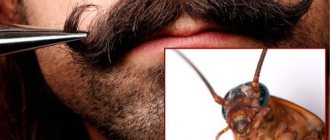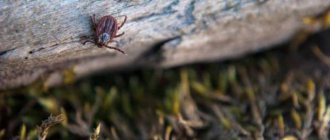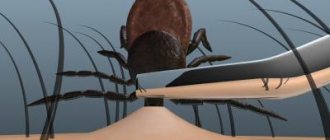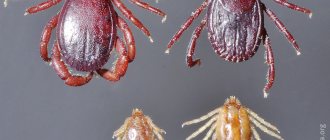Ticks in September and other autumn months. The phases of greatest activity of parasites, when they are most aggressive and dangerous. What dangerous diseases are carried? What symptoms should you pay attention to? How to remove an attached tick yourself. Possible methods of protection against ticks.
Many people believe that ticks are most dangerous in the spring, with the arrival of warmer weather, and during the rest of the period they do not pose a great danger. This opinion is erroneous because these parasites have two active seasons, the first is spring, the second is autumn.
If we talk about the threat they pose to humans and animals, ticks in September are just as dangerous as at any other time, since they are carriers of infection regardless of the season. Next, we will take a closer look at the active seasons, find out whether they are aggressive in the fall, what danger they pose and how to protect yourself from them.
Seasons of activity
If we talk about the seasonality of these parasites, it will be easier to determine the period when they are not active. After all, they are very tenacious and easily tolerate any climatic conditions if the air temperature rises above 6-8°C. The only climatic conditions under which they cannot lead an active lifestyle are frosts.
With the onset of frost, they go into a period of hibernation, fall asleep and disappear, and with the arrival of the first warmth they go through the following phases of activity:
- April May. The first phase of activity falls during this period. No one can say exactly when the seasonality of parasites will begin, since this is directly related to climatic conditions and temperature conditions. They wake up from winter sleep at an air temperature of 6-8°C. It is during this period that they are considered the most aggressive, since they are hungry and require nutrition for development and reproduction.
- June August. From the second half or end of June until August, a decrease in activity is observed. This is due to a period of temporary physiological rest, but at this time they can also attack people and animals, just in much smaller numbers.
- September October. The second phase of activity, when ticks become as aggressive as during the first phase. This is due to the fact that they require complete saturation in order to easily endure hibernation.
When the enemy is awake
Forest ticks have not one active period per year, but two. Spring begins when the air temperature reaches approximately +10° C. When this happens, parasites, hungry during hibernation, go hunting. By the way, unlike mosquitoes, the males of which do not feed on blood, in ticks both females and males suck blood.
Only the former take much longer to get enough. Their hunt for warm-blooded creatures lasts from about the end of April to mid-June. Well, then follows a period of diapause, after which, at the end of August, the parasites go on the attack again. This disgrace may last until mid-October. The time frame here largely depends on how warm the autumn season turns out to be. Ticks behave in the same way in the fall as they do in the spring; they simply don’t know how to do it any other way. The second period of activity is somewhat weaker than the first, but this does not make it any less dangerous for people and animals.
Appearance
These parasites belong to the group of arthropods, of which there are about 40 thousand species. Among them are ixodid parasites, whose diet consists of human and animal blood. Depending on the species, ticks can have different body sizes from 3 to 25 mm. The shape of the body is elongated and flattened, consists of a torso and head, and has fragments of elastic and hard tissue.
They have a piercing-sucking mouthparts, which they use to puncture the skin and stick to a blood vessel with their proboscis. The length of the proboscis may differ among individuals of different species.
They do not have organs of vision, but the absence of eyes does not at all prevent them from perfectly orienting themselves in space and easily finding food sources. The fact is that they have well-developed sensitive receptors, which replace the function of vision.
The body is covered with a kind of shield that protects the body from damage. In females it is small in size and covers only part of the body, while in males it covers completely.
They have 4 pairs of legs, each with a suction cup and claws, which allow the tick to hold firmly on any surface. Females always have larger body sizes than males, they also differ in color, the female has a brown tint, and the male is brown.
When saturated with blood, the parasites increase significantly in size; one individual can suck twice as much blood as it weighs. During saturation, the shape of the body changes, they become oval, and the color also changes to red.
You need to know the enemy by sight
- So, the most important thing is that ticks are as active in September as they are at the end of spring. An excellent sense of smell helps ticks find a food source in the forest. You can determine whether a tick is hungry or not with the naked eye. When it is full, its body enlarges and takes on an egg-shaped shape, changing color from brown to red. Until then, his “figure” is flat and has a pale appearance.
- The body of the parasite has a head and a body. The peculiarity of the structure of its skin allows it to absorb large amounts of blood and increase its mass 100 times. This effect is achieved due to the fact that the hard covers of the bloodsucker’s body alternate with elastic ones, gathered into folds.
- There is a protective shield on the top of the body. In males it covers the entire body, but in females it covers only part of it.
- These arachnids have 4 pairs of limbs. Each of them ends with a claw and a sucker. It is thanks to this that they move freely through trees and bushes, human clothing and animal fur.
- Visually, males and females differ both in size and color: males are smaller than females, their integument is brown. The shield of the female tick is also brown, and the rest of the body is brown.
A hungry tick is flattened and brownish in appearance.
Attention! Ticks are quite common in the Moscow region in September. The tick has a sharp proboscis. It can remain in the victim’s body for quite a long time. This statement is especially true for females.
What danger do they pose to humans?
Regardless of when exactly the tick attacks, in September or May, there is always the possibility of infection with dangerous diseases. These individuals are carriers of diseases such as encephalitis, borreliosis, fever, typhus and others. Of course, not all individuals are infected and carry the virus, but absolutely all can cause a number of other problems.
An insect bite can cause inflammation, irritation, and allergic reactions. There is always a risk of germs and bacteria getting into the wound, which will cause the wound to fester.
Also, if a blood-sucking substance is found on the body, you need to go to the hospital so that the doctor can remove it correctly. When removing an attached parasite yourself, there is always a risk of making mistakes. Fragments of insects may remain in the wound, infection may occur, etc.
What places to avoid
Unfortunately, there are simply no places where complete safety from these parasites is guaranteed. Regardless of whether you are going on vacation to the Moscow region or another region, during periods of activity they can be found in absolutely any territory.
There are some weather conditions that are not entirely suitable for them, such as dry and hot weather. Then they prefer to hide in shaded places where humidity is maintained. Large populations are found in deciduous and mixed forests; there are more favorable conditions for development and reproduction.
Regarding places that are best avoided in September and other warm periods, these include tall grass, shaded areas, willow trees, lake and river banks, and ditches. Of course, they can also be found in urban environments, especially parks. There is an opinion that parasites attack people by jumping from trees; these assumptions are misleading.
The fact is that these insects cannot tolerate direct sunlight, the ideal temperature is up to 21°C and necessarily high humidity. There are no favorable conditions for them at the tops of trees. In addition, these small parasites move very slowly and cannot cover long distances, and climbing to the top of a tree is not an easy task.
They are quite intelligent and hide in the grass and bushes near animal trails, where prey often passes and is easy to attack. In urban environments, they attack dogs and cats from the grass, and if a person passes, they cling to the legs and crawl upward to find a place to bite.
Are ticks dangerous in the fall?
Are ticks dangerous in the fall? — we’re trying to figure it out.
You need to know the enemy by sight. So, the most important thing is that ticks are as active in September-October as in late spring. An excellent sense of smell helps ticks find a food source in the forest. You can determine whether a tick is hungry or not with the naked eye. When it is full, its body enlarges and takes on an egg-shaped shape, changing color from brown to red. Until then, his “figure” is flat and has a pale appearance. The body of the parasite has a head and a body. The peculiarity of the structure of its skin allows it to absorb large amounts of blood and increase its mass 100 times. This effect is achieved due to the fact that the hard covers of the bloodsucker’s body alternate with elastic ones, gathered into folds. There is a protective shield on the top of the body. In males it covers the entire body, but in females it covers only part of it. These arachnids have 4 pairs of limbs. Each of them ends with a claw and a sucker. It is thanks to this that they move freely through trees and bushes, human clothing and animal fur. Visually, males and females differ both in size and color: males are smaller than females, their integument is brown. The scutellum of the female tick is also brown, and the rest of the body is brown. The tick has a sharp proboscis. It can remain in the victim’s body for quite a long time. This statement is especially true for females. Then the danger is especially great. There are certain periods during which tick activity is pronounced: from April to June, from August to October. The first tick season begins in the spring, when the air temperature warms up to approximately +10 degrees.
Adult bloodsucker.
An adult bloodsucker is dangerous at any time of the year, but especially in spring and autumn. Ticks come out of their sleepy state and wait for the right opportunity to get enough. This period of activity will last until mid-June. After this there will be a pause. The second wave of tick activity will begin from the end of August. Its duration depends on the weather conditions. If the autumn season turns out to be warm, then ticks in October will pose no less danger than in May. Ticks hide in the grass. For some reason, many people believe that ticks fall on humans from trees. This opinion is wrong. Such cases have happened, but they are the exception rather than the rule. These parasites love tall grass, which is abundant in forests. Their favorite places include willow trees and forest edges. The tick usually gets onto a person's shoes and clothing from grass or bushes, and then begins to move upward. Scientists say that ticks crawl in exactly this direction, looking for vulnerable spots. When going for a walk or picking mushrooms, pay special attention to your clothes. It is she who will be able to protect you, since a tick bite in September-October can cause big trouble.
Attention! Ticks are unevenly distributed in the forest. There are usually a lot of them where there are animals and birds. Ticks are concentrated along the natural movement areas of mammals. And also, the bloodsucker is not averse to getting a city “registration”, so don’t be surprised if you meet this enemy in a city park, in a country house, near reservoirs. There is a lot of grass in these places where ticks can be waiting for you. They love moist air just like mosquitoes. Ticks also accumulate in the fall on fallen old trees and dead wood deposits. When you pass near such places, look around yourself. Noticed ticks should be carefully removed from clothing.
Attention! Ticks can smell a person from 12-14 meters away. They are able to move with the wind, so they will cover this distance in a matter of seconds. On a plant, the tick strives to position itself so that the front pair of limbs can easily stretch forward when a potential feeder approaches. This pose is called the waiting pose.
How a tick attacks
When a tick lands on a potential feeder, it begins to move along it using claws and suction cups. He is looking for an unprotected area of skin to which he can attach. In humans, the most exposed places to danger, to which attention is paid first of all during examination, are considered to be: the neck, chest, armpits and inguinal cavities. Having attached itself, the tick secretes an anesthetic substance. Therefore, the bite is usually not accompanied by pain symptoms. Often the victim does not even notice that a tick has attached itself to it. When several hours have passed after attachment, its head will be completely immersed in the skin, and the body will swell from the sucked blood. The salivary glands of a tick are precisely the place that may contain the causative agent of encephalitis or another disease. Therefore, if a tick is infected, the pathogen enters the bloodstream along with its saliva. The main thing is not to panic: the correct method is to remove the bloodsucker.
If you are bitten by a tick, take immediate action
The attached tick must be removed as soon as possible. In this case, you need to be very careful - you cannot press or pull. After a few minutes, use a loop of strong thread. Gently rocking the loop, begin to pull out the tick. Try not to crush it, because this will allow the pathogen to enter your blood if it has not done so before. It is important to remove the tick correctly. When removing a tick, it is very important not to tear off the head.
It's very easy to protect yourself
The high activity of ticks in September-October makes it necessary to remember safety measures that will help maintain health: wear thick, closed clothing when going into the forest; shoes are tight and closed; trousers should have elastic at the bottom so that they fit snugly to the leg and do not allow the tick to get to the skin; Mandatory hand protection – a jacket/windbreaker with cuffs adjacent to the wrist. One important preventive measure is constant inspection of clothing. It should be done every half hour. Detecting a tick during a self-examination will allow you to promptly remove it from clothing and prevent a bite. On simple, plain, light-colored clothing, ticks are clearly visible. Avoid areas with grass vegetation - this is a key rule of behavior in the forest when tick activity is increased. Try to walk on well-trodden paths and paths. This will reduce the likelihood of ticks getting onto your clothes from the grass.
When the tick season ends, with the onset of the July heat and November frosts, ticks cease to pose a danger to humans.
If a tick does bite you, you should submit it for examination.
In Minsk, the examination is carried out at the city center of hygiene and epidemiology in the parasitology department from Monday to Friday from 8.30 to 18.00. And also on weekends - from 8.30 to 14.00.
Address: Republic of Belarus, 220013, Minsk, st. Petrusya Brovki, 13, building 1, phone Fax: 8 (017) 202-08-90 e - mail : minsk @ minsksanep
Healthcare Institution "1st City Children's Clinic"
Infection with dangerous diseases
The attack of females and males is different. Thus, a female can remain on the victim for up to 10 days and be saturated with blood all this time. She needs more food so that she can lay offspring.
Males attached to the body are more difficult to detect, since they quickly bite, gorge themselves and fall off on their own. When a tick falls on a person, it can crawl over the body for 2 hours to find a suitable place to bite. They look for areas where the skin is most delicate and where blood vessels are located closely.
They often choose places on the neck, behind the ears, under the arms, under the chest, near the shoulder blades, and the groin area, but they can also be found in other areas. The bite itself occurs as follows: the individual pierces the skin, while releasing an anesthetic enzyme, which is why they cannot be detected at this stage.
Next, they insert a proboscis into the wound and firmly attach themselves to the blood vessel. The infection virus is contained in saliva and products of the gastrointestinal tract; infection can occur immediately after a parasite bite.
How a tick attacks
The mite is often found on the neck and head
- When a tick lands on a potential feeder, it begins to move along it using claws and suction cups.
- He is looking for an unprotected area of skin to which he can attach. In humans, the most exposed places to danger, to which attention is paid first of all during examination, are considered to be: the neck, chest, armpits and inguinal cavities.
- Having attached itself, the tick secretes an anesthetic substance. Therefore, the bite is usually not accompanied by pain symptoms. Often the victim does not even notice that a tick has attached itself to it. When several hours have passed after attachment, its head will be completely immersed in the skin, and the body will swell from the sucked blood. The salivary glands of a tick are precisely the place that may contain the causative agent of encephalitis or another disease. Therefore, if a tick is infected, the pathogen enters the bloodstream along with its saliva.
Tick-borne encephalitis
Once in the body, the infection goes through an incubation period, after which the first symptoms of the disease appear. The period for symptoms to appear may vary; after an encephalitis tick bite, it can take from 3 days to 3 months until signs of infection begin to appear.
They are very similar to the symptoms of a cold or flu, so it is very important to remember the attack and consult a doctor immediately.
A person feels severe weakness, body temperature rises, headaches, joint aches, and drowsiness begin. Then the symptoms disappear for a while, and if a person took cold medicine, he thinks that he has simply been cured.
But in fact, the virus attacks the nervous system and brain. This leads to paralysis of the limbs and impaired motor activity. The disease can lead to decreased mental activity, muscle atrophy, and in severe cases, death.
A month earlier
Night mosquito: Russians are afraid of contracting HIV from blood-sucking mosquitoes
A Rosstat survey showed that citizens are poorly aware of the methods of transmission of this infection
In several regions of Russia, cases of tick bites were recorded back in February. Such episodes are observed in Novosibirsk, Magnitogorsk and the Moscow region. Thus, according to Tatyana, a resident of the Ramensky district, she noticed a tick on her dog while walking in the area of the Bronnitsy railway station.
As experts explained to Izvestia, it is considered normal if ticks wake up in April - this was the case last year. In early March, when the temperature is above zero, they can be found in well-warmed areas, even when there is still snow around. However, an abnormally warm winter in Russia can significantly affect the shift in the schedule of the “dangerous” season.
“If such warm winters are repeated, then the epidemic season of tick-borne infections will become longer,” Lyudmila Karan, a leading researcher at the Central Research Institute of Epidemiology of Rospotrebnadzor, told Izvestia. “For example, in Primorye it usually lasts seven months; ticks there wake up earlier and leave later than in other regions of the country. There may be cases of suction there in April and November. In other regions, the season begins about a month later and ends a month earlier. Now the example of Primorye may become typical for other regions of Russia.
ticks
Department of Virological Research, Microbiological Laboratory
Photo: RIA Novosti/Konstantin Chalabov
The expert noted that, in particular, mites of the genus Dermacentorus may be among the first to wake up. They are more dangerous for animals. Typically, these arthropods become active in April.
There is a season with the highest number of ticks - as Lyudmila Karan explained, at this moment the likelihood of a person encountering an arthropod increases as much as possible. Typically this peak occurs in June. Now this season may also shift towards spring, while the autumn period of activity will last longer.
Bloodlust
How to protect yourself and your pets from ticks
— It’s already getting warmer, the weather encourages people to leave the city earlier in the spring. And in the fall, they stay longer in nature, at the dacha, where they risk encountering ticks,” concluded Lyudmila Karan.
Tick-borne borreliosis
With this disease, external symptoms appear, in which the site of the attack turns red, a clear outline appears, and swelling appears. Then the redness subsides, the spot becomes pale and a bluish tint appears.
The first symptoms may appear after 30 days. External symptoms disappear after 2 weeks. Next, the virus begins to infect the brain, cardiovascular system, and blood vessels. The virus can remain in the body for 2-3 years and not make itself felt, causing irreparable consequences.
How to remove a stuck tick
If you have the opportunity to go to a medical facility, you should definitely do so. But if this is not possible, you can carry out the procedure yourself. To do this, you can use tweezers, thread, or special devices that can be purchased at the pharmacy.
Remember that the main thing is to correctly capture the parasite body. It is necessary to fix the parasite as close to the skin as possible in order to hold not only the abdomen, but also the head. Next, you should unscrew the parasite and pull it up a little. You should not make sudden movements, tear it out of the wound, or apply too much pressure; all this can lead to rupture of the parasite and increase the likelihood of infection.
There are situations when the removal is carried out incorrectly and the head or other fragments of an insect remain in the wound; they must be removed, otherwise inflammation and rotting of the wound will begin. To do this, a needle is used; it must be picked up with the remaining particle. If it is deep in the wound, it is necessary to go to the hospital.
The insect that was managed to be removed from the wound must be placed in a jar and submitted for analysis to a laboratory, where research will be carried out and the results will show whether the tick is infected. This will allow you to use the correct treatment in the early stages and prevent complications.
The main thing is not to panic: the correct method for removing a bloodsucker
If you are bitten by a tick, take immediate action. The attached tick must be removed as soon as possible. In this case, you need to be very careful - you cannot press or pull. It is better to contact a medical facility. If this is not possible, first the bite site should be lubricated with a fatty substance or liquid. After a few minutes, use a loop of strong thread. Gently rocking the loop, begin to pull out the tick. Try not to crush it, because this will allow the pathogen to enter your blood if it has not done so before.
When removing a tick, it is very important not to tear off the head
Attention! You won’t be able to find out whether a tick was infected or not on your own. Once removed, place it in a bag and bring it to the hospital for examination.










